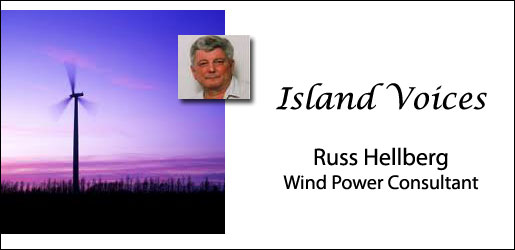Russ Hellberg December 2008
Current Article ∙ Archive ∙ Back to Island Voices
Challenges for the Wind Industry
This month I am using a message from Canadian Wind Energy Association (CanWea) President Robert Hornung to update the wind industry on the economic events that are troubling this industry just as they are affecting many other sectors.
Dear CanWEA Members,
We live in interesting times. While the current political and economic uncertainty in Canada poses some real challenges for the wind energy industry in the short-term, there is no doubt that future prospects for our industry in Canada remain very positive.
At the political level, the current uncertainty about the future of Canada’s federal government has made it more challenging to advocate for an extension and expansion of Canada’s ecoENERGY for Renewable Power program. That said, I believe there is a growing recognition among all political parties that ecoENERGY represents a fiscally responsible way to leverage significant private sector investment in electricity infrastructure at a time when the government is seeking to stimulate economic activity. I will keep you posted on our efforts to push for ecoENERGY expansion / extension to be included in an economic stimulus package that is separate from or part of a federal budget.
Looking a bit further into the future, I am pleased to report that the federal government has now initiated a process to develop a “Policy and Technology Road Map” for wind energy development in Canada. This process, which began last week in Montreal, is bringing together more than 100 stakeholders with an interest in wind energy development in Canada to design a “road map” of the policy and technological initiatives required to significantly advance the wind energy industry in Canada. At last week’s meeting, participants agreed to use CanWEA’s WindVision 2025 (20% of Canada’s electricity from wind energy by 2025) as the target the “road map” would seek to move us toward. This process will continue through January and February with a final report to be issued in Spring 2009. The “road map” will develop recommendations for federal and provincial governments on the policy and technological initiatives required to move wind energy forward in Canada in the following areas: (a) economics and markets, (b) wind resource assessment, (c) large wind turbine supply and value chains, (d) transmission, (e) integration, and (f) small wind energy systems. CanWEA is a member of the Steering Committee for this process (as are several CanWEA members) and I will keep you posted on its progress. We believe this initiative can help to define the research and concrete actions that will be required to make WindVision 2025 a reality.
At the economic level, it is clear that the current credit crunch will have an impact on the wind energy industry. In an industry as capital intensive as ours, any situation that both shrinks the pool of funds available for financing and increases the costs of accessing those funds represents a real challenge and will lead to increased project costs. Nonetheless, recent request for proposal processes in both Ontario and British Columbia received far more bids from wind energy project proponents than were being sought in the process. While it is likely that we will see some more consolidation in the industry and a delay or cancellation of some projects (as we are seeing in all industry sectors), interest in developing wind energy remains very strong.
What separates the wind industry from other industrial sectors at this time is the fact that the fundamental drivers that have supported rapid growth in the industry remain in place. Wind energy is growing rapidly because there is a broad and growing recognition among policy makers that we need to: (a) improve the environmental performance of electricity generation, (b) bring new generation on quickly, (c) provide economic stimulus to declining rural economies, and (d) we need to find new jobs for those who have lost jobs in traditional manufacturing sectors in more sustainable industries. As a result, we are likely to see governments continue to support wind energy and seek to stimulate private sector investment in wind energy development.
These are challenging times, but the wind industry has survived even greater challenges in the past. Future prospects remain bright.
P.S. I am pleased to report that the commissioning of several wind farms in Canada in October and November has now brought Canada’s installed wind energy capacity to 2,246 MW. Congratulations to the following projects:
• Cartier Wind – Carlton Wind Farm – 109.5 MW (Quebec)
• Kruger Energy – Port Alma Wind Farm – 101.2 MW (Ontario)
• AIM SOP Phase 1 – Mohawk Point Wind Farm – 9.9 MW (Ontario)
• Enbridge – Cruikshank Wind Farm – 8.25 MW (Ontario)
• Canadian Hydro Developers – Melancthon II – 132 MW (Ontario)
About CanWEA
The Canadian Wind Energy Association (CanWEA) and its members advocate the responsible and sustainable growth of wind energy throughout Canada. For more information on wind energy development in Canada visit: www.canwea.ca


